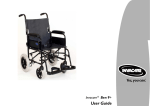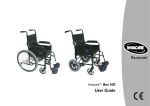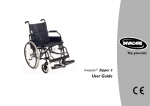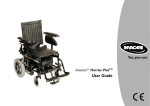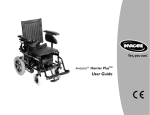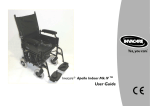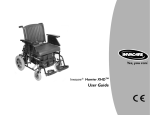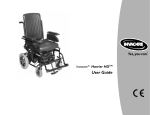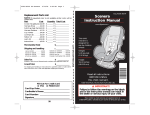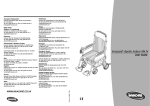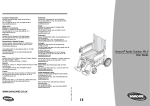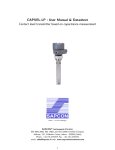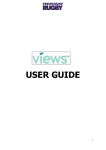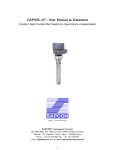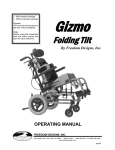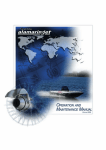Download User Manual
Transcript
NXT™ Generation NEXT Paediatric & Adult Folding Tilt Wheelchair User Manual This manual msut be given to the user/care giver of the product. Before using the wheelchair, read this manaul and save for future reference. Table of Contents Useful Symbols In This Guide Introduction Warranty Terms & Conditions Limitation of Liability Intended Use 2 3 4 5 6 Safety & Operating Limits Weight Limit Reaching For An Object From A Wheelchair Transferring To Another Seat Tilting The Chair Kerbs, Or Obstacles 30mm To 50mm High Steps, Stairs Or Obstacles Over 50mm High Upward & Downward Slopes (Operating Limits) Summary Of Safety Instructions 7-16 7 General Descriptions NXT™ Features Use Unfolding the NXT Folding the NXT Main Frame Latch Style Swing Away Hangers Pop-up Hangers Flip-up Individual Footplates Angle Adjustable Footboard Quick Release Axles Flip Back and “T”- Armrests Fixed Height, Removable Armrests Adjustable Height Flip Back Armrests Castors Wheel Locks Folding Back Tilt Operation Leverage Bar Operation NXT Adjustments Tilt Cable Adjustment Backpost Adjustments Armrest Adjustments Castor Fork Adjustments Wheel Lock Adjustments Rear Axle Adjustments Anti-tip Adjustment Cleaning And Maintenance Storage Troubleshooting - Mechanical Transportation Product End Of Life Contacting INVACARE 7-8 9-10 11 12 13 14 15 16 17 18-24 18-19 20-21 22-27 22 23 24 25 26 26 27 27 27 27 28 28-29 29 1 30-33 30 30 30 31 31 32 32 33 33 34-35 36-37 37 38-39 Useful Symbols Useful Symbols In This Manual WARNING! This symbol warns you of danger! Always follow the instructions to avoid injury to the user or damage to the product! EXPLOSION HAZARD! This symbol warns you of an explosion hazard, an example of which can be caused by excessive tyre pressure in a pneumatic tyre! • Always follow the instructions to avoid injury to the user or damage to the product. NOTE: This symbol identifies general information which is intended to simplify working with your product and which refers to special functions. REQUIREMENTS: This symbol identifies a list of various tools, components and items which you will need in order to carry out certain work. TRANSPORTATION: This symbol identifies important information relevant to transporting your wheelchair in a motor vehicle. 2 Introduction Introduction Thank you for purchasing your Freedom Designs, Inc. NXT™ wheelchair. The NXT™ combines state-of-the-art technology with durablility and function to meet all of your changing needs. This operating manual will provide you with a detailed guide for proper use as well as instructions on the care of your new NXT™ wheelchair. Please follow the instructions carefully, paying special attention to the ‘Safety Precaution’ section. It is important that you read the entire operating manual before operating the NXT™. After consulting your operating manual, if you have further questions, please contact one of our authorised dealers. Note for Customers INVACARE provides a wide range of wheelchairs to meet the requirements of customers. However, the decision on the type of model to be prescribed rests exlusively with experienced advisors. INVACARE or its appointed representative shall not be held responsible if a wheelchair is used that is unsuitable for the user’s level of disability, if the wheelchair itself is incorrectly used or if a problem arises due to poor maintenance. The information set out in this manual may be modified without prior notice. This manual contains copyright information. All rights are reserved. No part of this document may be photocopied or reproduced without prior written agreement from INVACARE or its appointed representative. This manual gives details of all the options of the NXT™ wheelchair. It describes the options, operation and adjustments that mey be required. However, your INVACARE retailer will be able to give you further information and demonstration. 3 Warranty Terms & Conditions Warranty Terms & Conditions Standard INVACARE Terms This is to certify that your wheelchair is warranted by INVACARE Ltd. for a period of 1 year for parts, 2 years for hardware and frames. 1. Only INVACARE chairs purchased at full price are warranted against defective workmanship and materials. 2. If a defect or fault is discovered the INVACARE dealer from whom the wheelchair was obtained should be notified immediately. 3. The manufacturer will not accept responsibility for damage caused by misuse or non-observance of the instructions set out in the user manual. 4. During the period of the warranty any parts that have become defective, due to faulty workmanship or materials, will be renewed or repaired without charge by the INVACARE dealer. 5. The warranty will be invalid should any unauthorised alteration be made to the equipment. 6. The purchaser’s statutory rights under the Consumer Protection Act are not affected. 4 Limitation of Liability Limitation of Liability This warranty does not extend to the consequential costs from fault clearance, in particular freight and travel costs, loss of earnings, expenses, etc. • Natural wear and tear. • Inappropriate or incorrect use. • Defective assembly or setting-up by the purchaser or third parties. • Defective or neglectful treatment. • Use of unsuitable spares. 5 Intended Use Intended Use The NXT™ manual wheelchair has been designed to provide mobility and comfort for persons with impaired mobility. The wheelchair has been designed to be used by a seated user with a carer/ attendant in both indoor and outdoor environments. The wheelchair has, in its standard format, been designed to accomodate users who weigh up to a maximum weight of 91Kg (14.4 stone) for all sizes, have all limbs intact and have sufficent upper body strength to maintain a safe position within the wheelchair without the addition of supporting aids. Adaptations from the standard wheelchair format are available to accommodate users who do not meet the above criteria but these will only be considered after a suitable risk assessment has been carried out by the product prescriber. For example, a user with either a full or partial amputation or other condition, which affects the natural centre of gravity will need to have a stability evaluation to minimise the risk of inadvertent tipping. The wheelchair should only be used in accordance with the safety advice given within this user guide. Failure to follow the recommended advice within this user guide could lead to personal injury. No claims are made that the product will medically improve the circumstances or condition of the user. 6 Safety & Operating Limits Safety & Operating Limits Stability and Equilibrium To ensure that the wheelchair remains stable and is manipulated correctly, you must always maintain good equilibrium. Many actions cause the user of a wheelchair to reach out, lean over or move about within the wheelchair and outside it. These actions will change your centre of gravity and weight distribution of the wheelchair. Your wheelchair has been designed to remain stable for normal everyday use if it is used correctly taking the precautions recommended in this manual. Weight Limit The maximum user weight limit is 91Kg (14.4 stone) for all sizes and configurations. However, the wheelchair user’s level of activity is important. For example, an active user weighing 60Kg may subject the wheelchair to more stress than a less active user weighing 90Kg. We recommend very active wheelchair users to choose an appropriate design of wheelchair. Your INVACARE approved distributor will advise you on the best model. Reaching For An Object From A Wheelchair The limitations on reaching out from a wheelchair shown in Figure 1 have been produced using a representative sample of wheelchair users. Only the arms should extend beyond the seat of the wheelchair. For safety reasons, the body and head should remain within the wheelbase. Position the castors to give the longest possible wheelbase (Figure 2). Lock the manual brakes on the rear wheels. 7 Safety & Operating Limits Leaning Forwards (Figures 3, 4, 5) Move the wheelchair as close as possible to the object you wish to reach. Only reach out for objects that are within arm’s length in a normal sitting position. Leaning Backwards (Figures 6, 7) Move the wheelchair as close as possible to the object you wish to reach. Only lean back for objects that are within arm’s length in a normal sitting position. 8 ! Safety & Operating Limits ! Transferring To Other Seats Leaning To One Side (Figure 8) This is a dangerous manoeuvre as it is easy to tip sideways. To move up to an object and lean over, you must use the castors as a means of keeping the wheelchair stable and balanced. For your safety, it is essential to be in the correct position. Do not try to pick something up from the floor if this would upset your balance. It is possible to move from and to a manually propelled chair if the following guidelines are followed. INVACARE does not reccomend any particular method for transferring: This is the responsibility of a medical advisor who should consider your level of disablity and type of wheelchair. When transferring, either to get out of or return to your wheelchair, make sure that the gap between the two seats is as small as possible. (Figures 9, 10) 9 ! Safety & Operating Limits ! When transferring, either to get out of or return to your wheelchair, make sure that the manual brakes on the rear wheels are on to prevent the wheels moving (Figure 11). Turn both castors towards the seat to which you wish to move. Lift up the footplates (Figure 12). Do not stand on the footplates. If possible, swing the legrest hangers out to the side to clear the passage (Figure 13). If possible, flip up the armrests on the side between the wheelchair and the other seat (Figure 14). Note: Never stand on the footplates (Figure 15). 10 ! Safety & Operating Limits ! Tilting The Wheelchair To tilt the wheelchair (Figure 16), a second person should grip the handle firmly. Warn the user of the wheelchair before tilting it and remind him/her to lean backwards. Check that the user’s feet and hands are clear of all the wheels. Push smoothly until the wheelchair is at the point of equilibrium. At this stage, the helper will feel a difference in weight distribution. Turn the wheelchair in the direction required and negotiate the obstacle. Lower the front of the wheelchair smoothly, holding the handles firmly. Do not lower the wheelchair suddenly for the last few centimeters before returning to the normal position, this may cause discomfort. 11 ! Safety & Operating Limits ! Kerbs, Or Obstacles 30mm To 50mm High Method 1 - Negotiating the obstacle forwards (Figure 17) The helper should tilt the wheelchair until the castors have passed over the kerb. Move the wheelchair forwards and lower the castors gently onto the pavement. Push the wheelchair until the rear wheels touch the kerb. Lift and push until the rear wheels have mounted the kerb. Do not just lift by the handles on the backrest. Method 2 - Negotiating the obstacle backwards (Figure 18) The helper should stand on the pavement and turn the wheelchair until the rear wheels are against the kerb. Tilt the wheelchair backwards to the point of equilibrium and, in a continuous movement, pull the wheelchair until the rear wheels mount the kerb and pass onto the pavement. Do not lower the castors to the ground until you have pulled the rest of the wheelchair sufficiently far to clear the kerb. Note: Folding backs should always be checked to ensure they are engaged. 12 ! Safety & Operating Limits ! Steps, Stairs Or Obstacles Over 50mm High We recommend that you take very great care when taking a wheelchair up or down stairs. Two people are required for this. ADVICE TO SECOND OR THIRD PERSONS: Make sure that you get hold of fixed, non-removable parts only! Using the following procedure for going upstairs (Figure 19): Tilt the wheelchair to its point of equilibrium. One helper (at the back) holds the wheelchair up against the first step, gripping the handles firmly to lift. The second helper, holding a firmly fixed part of the front frame, lifts the wheelchair above the stairs and holds it while the first helper places one foot on the following step and repeats the operation. The wheelchair must not be lowered until the last step has been negotiated and until the chair is clear of the stairs. Escalators Do not use an escalator when moving a wheelchair from one floor to another. This might cause serious injury. 13 ! Safety & Operating Limits ! Upward & Downward Slopes (Operating Limits) Do not attempt to go up or down slopes greater than 10% without assistance (Figure 20). Always go straight up and down slopes otherwise the wheelchair might overturn (Figure 21). 14 Safety & Operating Limits Summary Of Safety Instructions Summary of instructions for use for improved safety: • • • • • • • • • • • • • • User weight limit (including accessories): 91Kg (14.4 stone) for all sizes. Do not try to reach objects if you have to move forward on the seat. Do not try to reach objects on the ground if you have to lean down beyond the safety limits. Do not lean too far back to reach objects behind you: you may tip over. Do not move your weight, or your sitting position in the direction in which you wish to go: you may tip over. Always apply both manual brakes before trying to get out of or back into the wheelchair. The manual brakes are not designed for slowing you down. Do not try to stop a moving wheelchair using the manual brakes. Do not use an escalator for moving a wheelchair from one floor to another. (This may cause serious injury). Do not use your wheelchair if the tyres are not inflated to the correct pressure shown on the side. Do not over-inflate the tyres. Failure to comply with these instructions may cause the tyre to burst and cause bodily injury. Carry out the regular checks recommended in this guide and by your INVACARE approved retailer. Use your wheelchair with respect for other people. Do not use your wheelchair as a transport seat in a vehicle. unless it is not practical for the user to be transferred (Refer to page 31 - Transport). 15 General Descriptions General Descriptions Each wheelchair is specially designed to meet the requirements of its user. This manual describes how to adjust the chairs in this range, enabling you to find out how to adjust the wheelchair to suit your needs. General Descriptions Your wheelchair has a number of main parts which will be mentioned throughout this manual. These parts are described below. Support is provided by the backrest, seat and armrests. The chassis comprises of the side frames and cross brace. This is the essential supporting framework of the wheelchair on which all the other parts are mounted. The front castors comprise of the fork and wheels. The front wheels provide contact with the ground and the rotating forks steer the chair. Manual brake - The manual brake is used to park the wheelchair. Swing away footrest support and leg rest - These are connected to the chassis and can be swung away to make transfer easier to and from the wheelchair. The footplate assembly comprises of the adjustable tube and foot plate. These support your feet. The heel support strap or calf support strap. These two straps support your feet or legs in the best position. These parts are illustrated on the following page. 16 Features NXT 21 1 20 19 2 18 3 17 4 16 5 15 14 6 13 7 8 9 10 11 12 1. Swing Away Hanger (pop-up or latch style) 12. Anti-tip Tube without Leverage Bar 2. Flip-up Footplates 13. Axle Adjustment Plate (not shown) 3. Seat Frame 14. Anti-tip Tube with Leverage Bar 4. Tilt Mechanism 15. Backpost Adjustment Plate 5. Base Frame 16. Backpost Release Trigger 6. Castor Fork 17. Backpost 7. Castor Wheel 18. Arm Height Adjustment Clamp 8. Folding Crossbraces 19. Flip up Arm 9. Wheel Lock 20. Lifting / Folding Strap 10. 12” Mag Wheel 21. Solid Seat & Back (optional) 11. Quick Release Axle 17 Unfolding the NXT For ease of transporting and lifting, the NXT can be easily unfolded and folded. Always engage the wheel locks by pushing forward or pulling back on the levers or engaging the foot lock before unfolding the chair. (see page 27). Seat Frame Receiver 1. Unfolding is accomplished by applying even downward pressure on the cross braces. The cross braces will lock into place. Note: The cross braces need to be opened to their maximum point where the stops rest in the notches of the cross brace and lock into place. 2. Grasp the push handles and push them to an upright position where they will lock into place in the seat frame receivers. This operation must always be done prior to assembling the seating to the wheelchair. 3. Push the flip back armrests down to the flat position or insert optional T-arm or Dual Post Armrests into receiver socket until it snaps into place. 18 Unfolding the NXT 4. Attach Footrest Hangers (See pages 21-22) Note: The NXT can be folded and unfolded while the footrest hangers are attached. 5. Flip down the footplates or attach the footboard and place in the “down” position. (See pages 24-25) 6. Turn both anti-tip tubes to the downward position until they “click” into place. (See page 21). 19 Folding the NXT Always engage the wheel locks by pushing forward or pulling back on the levers or engaging the foot lock before unfolding the NXT. (see page 27). 1. Flip up the individual footplates or remove the footboard. (See pages 24-25). Note: The NXT can be folded and unfolded while the footrest hangers are attached. 2. Remove the footrest hangers. (See pages 22-23) 3. Flip back the armrests to the upright position. Or remove armrests . Note: The armrests need not be removed to fold the NXT but must be removed to fold the backposts down. 4. Pull up on the trigger mechanism for the backposts and push the backposts to the flat position over the seat rails. 20 Folding the NXT 5. Rotate the anti-tip tubes upward as shown until they “click” into place. 6. Pull up on nylon cross brace strap to fold the chair. Note: Use the provided nylon strap to fold the chair. Be careful not to place your fingers between the folding crossbrace. 7. Disengage wheel lock, push the quick release axle button and pull wheel off of the frame. 21 Main Frame Latch Style Swing Away Hangers The NXT frames ship standard with swingaway hangers in 75° or 90° 1. To swing away the hanger, place your finger tip on the inside of the hanger release lever. 2. Pull outward on the lever (away from the chair). This will enable the hanger to swing away for ease of transfer. 3. To remove the hanger, lift the hanger upward until the pivot saddle is out of it’s frame receiver. 4. To attach the hanger, insert the pivot bushing into the frame receiver tube, at an angle as shown. Rotate the hanger inward until the latch snaps into place. 22 Main Frame Pop-Up Removable Hangers The NXT frames my be shipped with optional pop-up hangers in 75° or 90°. 1. To remove the hanger, place your hand on the hanger release lever. 75° hanger 90° hanger 2. Pull back on the lever towards the chair. This will enable the hanger to pop-up and swing away for ease of transfer. 3. To remove the hanger, lift the hanger upward until the pivot saddle is out of it’s receiver on the frame. 4. To attach the hanger, line up the pivot saddle with it’s receiver on the frame and insert downward pressure until hanger locks into place. 23 Main Frame Flip-up Individual Footplates The NXT is shipped with individual flip-up footplates attached or a solid footboard unattached. Adjustment of the individual flip-up footplates are as follows: To adjust the height of the footplate : 1. Remove the nylon lock nut on the back side of the hanger. Place the footplate at the desired height. Insert the screws through holes in the hanger tube, install lock nut and tighten securely. To adjust the angle of the flip-up footplate 2. Loosen the screws on bottom of the footplate. Set the footplate at the desired angle and re-tighten. To adjust the depth of the flip-up footplate 3. Loosen and remove the screws on top of the footplate. Align the holes in the footplate with holes in the clamp at the desired depth install the screws and tighten. To flip the footplate 4. The individual footplates easily flip by lifting underneath the footplate to flip up or push down on the footplate to flip down. 24 Main Frame Angle Adjustable Footboard 1. To attach the footboard to the frame, place the footboard clamps on the frame. Set the clamps at the desired height. Insert the receiver into the clamps and tighten the 2 hex head screws on each side. 2. To remove the footboard for transfer, screw the knob assemblies underneath the receivers. Lift the footboard upward, out of the receivers. 3. To attach the footboard after transfer, align the footboard fittings into the receivers. Turn the knobs on each side to tighten. 4. To change the angle of the footboard, use an allen wrench and loosen the flat head screws on the top of the footboard. When the desired angle or depth is reached, tighten both screws. 5. To change the height of the footboard on the frame, loosen the 2 hex head screws on the footboard frame clamps. Set the desired height and tighten. The lowest point of the footrest plate should be at least 2 1/2” from the ground to ensure the proper clearance. Warning: In all footplate and hanger adjustments, be sure that all screws are tightened securely for your safety. 25 Main Frame Quick Release Axle* The NXT is equipped with double lock quick release axles that release with the push of a button. This double lock quick release mechanism allows the rear wheels to be easily removed for transportation or storage. To remove the rear wheel: 1. Unlock the wheel lock. 2. Grasp the frame with one hand. 3. With the other hand, squeeze the quick release button. 4. The wheel will then pull off easily. Warning: The axle is not properly locked until the outside quick release button pops out to its full extended position. *Patented Flip Back Arm The NXT is shipped with flip back armrest as standard equipment. The flip back armrests are non removable and are available in either locking or non locking. Locking Flip Back Arm To flip the arm back, push the trigger mechanism Single Post Height Adjustable “T” Arm To remove the “T” arm, push lever toward the center post and lift arm out of receiver socket. 26 Main Frame Castors The NXT comes with a range of castor sizes dependent on either choice or seat to ground height. Push or Pull to Lock Wheel Locks The NXT comes standard with push to lock or pull to lock wheel locks. To lock wheels in place: 1. Grasp the lever of the wheel lock with your hand. 2. Pull or push the lever back or forward to release the wheel lock. ! CAUTION ! Always set the wheel locks when entering or leaving the wheelchair. Wheel locks are not designed to slow the wheelchair down when it is moving. Wheel locks hold the wheelchair in place when it is at a complete stop. 27 Main Frame Folding Back The NXT come standard with a folding back. 1. To fold the back down, pull upward on the trigger while pushing backposts forward toward seat. 2. To place the backpost to the upright position, pull backposts up until trigger snaps into place. Note: The backposts fold down completely when using a solid seat and back. When using a sling seat and back the backposts will only fold partially Tilt Operation The standard method of tilt activation is with the use of a foot pedal. A single back cane mounted release is optional. Foot Pedal Release Procedure Rearward Tilt 1. Engage wheel locks. Foot Pedal Rotate Back Canes 2. To activate the tilt on the NXT, grip the push handles with both hands, press down on the foot pedal and hold down (flip foot pedal down if necessary) and rotate the push handles downward. 3. When the angle of tilt is in the desired position, release the foot pressure. The tilt will lock into place. Forward Tilt (toward flat seating position) 1. Engage wheel locks. 2. To bring the NXT seat and back frame toward the upright position (out of tilt), grip the push handles with both hands, press down on the foot pedal and hold down, rotate the push handles upward. Foot Pedal 3. Release the foot pressure when the forward tilt position has been achieved. 28 Main Frame Back Cane Lever Release Procedure Rearward Tilt 1. Engage wheel locks. 2. To activate the tilt on the NXT using the optional back cane mounted lever , grip the push handles with both hands while also gripping the release lever. Squeeze the lever and hold while rotating the push handles downward. 3. When the angle of tilt is in the desired position, release the lever. The tilt will lock into place. Forward Tilt (toward flat seating position) 1. Engage wheel locks. 2. To bring the NXT seat and back frame toward the upright position (out of tilt), grip the push handles with both hands, while gripping the release lever. Squeeze the lever and hold down while rotating the back canes upward. 3. Release the pressure on the lever when the forward tilt position has been achieved. Leverage Bar Instructions One of the anti-tip assemblies may be used as a leverage bar to assist in tipping the wheelchair in order to roll over kerbs and other obstacles. Rotate the anti-tip assemblies to the upward position (see picture) Place your foot on the straight portion of the tipping lever. Press down with your foot while pulling back and pushing downward on the backrest push handles. 29 Adjustments Tilt Cable Adjustment Jam Nut Threaded End At least one end of each cable will have a threaded end fitting, adjust nut & jam nut. Fitting If the seat tilt locks do not release when the foot pedal or hand lever is depressed, loosen the jam nut and adjust the threaded end fitting outward (turn adjust nut counterclockwise). If the Adjust Nut lock does no hold properly adjust the threaded end fitting inward (turn large nut clockwise). Re-tighten the jam nut securely. Note: Seat lock cables should be adjusted by a qualified technician. Backpost Adjustment The angle and depth of the backposts may be adjusted by repositioning the backpost pivot plate in the pre-drilled holes on the frame. Flip Arm / Locking Arm To adjust height of armrests, loosen and remove the bolts and nuts holding the arm to the backpost tube. Align holes in arm with holes in backpost tube at desired height. Re-assemble with bolts and nuts. “T” Arm To adjust the height of the “T” arm, rotate lever outward. Lift or lower arm pad to desired height and rotate lever back to forward position to lock in place. 30 Adjustments Adjustable Height Flip Back Armrest To adjust the arm height, flip the release lever (under the front of the arm pad) to the horizontal position. Slide the arm upward to the desired location. Flip the release lever back to the vertical position. Castor Fork Adjustment Interchanging castors can easily be done with dual hole castor forks. Currently, 3”, 5” , 6” and 7” castors are available for use. A smaller fork is used with the 3” castor only. To adjust, loosen the bolt and remove the castor. Change the castor and/or position the castor upward or downward in pre-drilled holes on the castor fork. Replace the bolt and tighten securely. Wheel Lock Adjustment When the rear wheel is repositioned, it is important that the wheel lock is readjusted also. Adjustment can be made by loosening the 1/420 x 1” button head screws and sliding the wheel lock assembly along the frame tubing so that the wheel lock contacts the tyre in the locked position. Continue to adjust until the knurled grip handle embeds into the tyre approximately 1/4” when in the locked position. Tighten the screw until wheel lock is snug to frame tube. ! WARNING ! Wheel locks are not designed to slow the chair down when it is moving. When the chair is stopped, engaging properly adjusted wheel locks will prevent the rear wheels from turning. 31 Adjustments Rear Axle Adjustment The position of the rear axle is the most critical adjustment on the NXT wheelchair. The center of gravity and the seat height position are all determined by the axle adjustment. Warning: Your healthcare professional should assist you in adjusting the axle position. Position of the axle will be based on your abilities and limitations. Center of gravity adjustment may be accomplished by moving the rear axle plate forward or backward on the frame. Seat height and/or angle may be changed by changing the position of the axle upward or downward on the axle plate. Warning: Your healthcare professional should assist you in adjusting the axle position. Position of the axle will be based on your abilities and limitations. Warning: The wheelchairs become less stable if forward axle positions are used. The further forward the axles are positioned, the easier it is to tip the chair over forward or backward. Moving the axle backward will increase the stability of the chair. This backward adjustment will create increased turning pressure. Note: A front castor adjustment should be made to correspond with any changes in rear seat height/angle. Anti-tip Lever Adjustment Height 1. Loosen the screw and nut on the anti-tip roller assembly. 2. Raise or lower anti-tip roller assembly until desired height is attained.(recommended at 1-1/2” to 2” off of the ground). 3. Re-install screw and nut. Tighten securely. 4. Repeat procedure on opposite anti-tip lever. 32 Cleaning & Storage Cleaning It is important for optimum performance to clean and maintain your NXT™. We recommend that the frame finish be cleaned with mild soap and water. In order to operate the NXT™ properly and safely, routine maintenance will extend the life and efficiency of your wheelchair. Safety Inspection Checklist Follow these maintenance procedures for optimum performance of your NXT™ wheelchair: 1. Check to see that the wheelchair rolls straight. 2. Tyres: Check for flat spots, wear and proper inflation. 3. Wheel lock: a. Check to see that the locks engage easily. b. Check that the locks are free of wear c. Check to see that the locks do not interfere with the tyres when rolling. 4. Ensure that all fasteners are secure. 5. Castors: Inspect axle for proper tension. Spin the castor. The castor should spin freely and come to a gradual stop. Storage The NXT™ folds down to a small unit and the rear wheels may be removed. We suggest when storing the wheelchair, that it be stored in an indoor, cool and dry area. 33 Trouble Shooting A list of authorised repair facilities may be obtained from: Invacare UK Ltd. Pencoed Technology Park Pencoed Bridgend CF35 5HZ Tel: 01656 776222 Fax: 01656 776220 E Mail: [email protected] Invacare Ireland Unit 5, Seatown Business Campus Seatown Road Swords County Dublin Ireland Tel: + 353 1 8107084 Fax: + 353 1 8107085 E Mail: [email protected] Web: www.invacare.ie Trouble Shooting - Mechanical Initial adjustments should be made to suit personal body structure/user capability and preference. Thereafter, follow these maintenance procedures: Chair Veers Left/Right Sluggish Turn/ Performance Castors “flutter” X X X X X X Squeaks & Rattles If pneumatic, check tyres for correct and equal pressure X Looseness in Chair Solutions Chair “3 Wheels” X Check for loose stem nuts/bolts X Check that both castors contact ground at the same time Solutions If pneumatic, check tyres for correct and equal pressure X X Check for loose stem nuts/bolts 34 Trouble Shooting Checking The General Condition For maintenance operations, consult your distributor who has all the necessary information. Ask your distributor to annually inspect your wheelchair thoroughly and carry out in depth maintenance. Regular maintenance allows defective or worn parts to be identified and improves the normal operation of your wheelchair. The following table shows what to check when the wheelchair is delivered, each week, each month and at 6 monthly intervals. Checks to be Made: On delivery Weekly X X Monthly 6 Monthly 1. General: The wheelchair moves in a straight line (no resistance or drag) 2. Manual brakes: The manual brakes do not touch the tyres when moving X The manual brakes are easy to operate X The articulations are not worn and do not show signs of play X X X X 3. Frame work Examine them to check that they are not worn or bent X X 4. Clothing protectors/armrest upholstery Check that all fixings are in position and tightened X 5. Armrests X Firmly attached but easy to remove X 6. Arm Pads/Foam X Check that the padding is in good condition X 7. Seat and backrest upholstery X X X X X X If the wheelchair has pneumatic tyres, check that they are correctly inflated (the pressure is shown on sidewall) X X If the wheelchair has solid tyres, check the running surface X X Check that it is in good condition 8. Castors Check the axle to ensure that it is correctly tightened, by turning the castor. The castor should stop gradually 9. Fork / Fork tube Check that all the fittings are in place 10. Pneumatic and solid tyres 35 Transport Transport INVACARE always advises that a wheelchair secured in a vehicle will not provide the equivalent level of vehicle seating systems and recommends transfer to the vehicle seating, but also recognises that it is not always practical for the user to be transferred. In those cases where it is considered that the user must be transported whilst within the wheelchair, then the following advice should be followed. Note: The wheelchair user safety during transportation largely depends upon the diligence of the person securing the tie downs and passenger restraints. 1. 2. 3. 4. 5. 6. 7. Seek confirmation from the transporter that the vehicle is suitable designed and equipped to transport a passenger seated in a wheelchair. Any part of the wheelchair (accessories, etc.) that can be easily detached should be removed and stored in the vehicle luggage hold during transportation. The wheelchair should always be transported in a forward facing direction. Rearward facing is only acceptable if the occupant’s head and back can be supported by a suitable bulkhead. INVACARE recommends that the wheelchair be secured by 4-Point webbing tie down systems as manufactured by Unwin Safety Systems or Koller Safety Resraint Engineers. When attaching tie down systems to the wheelchair it is imperative these are fixed onto the main frame of the wheelchair and not onto any attachments or accessories (not wheels, handrims, castors, footrests, anti tipping levers etc.). Tie down points are indicated by the tie down stickers in the correct areas. The tie downs should be secured, as close as possible, at an angle of 45 degrees to ensure maximum effectiveness of the restraint in all directions. The occupant should be restrained independently of the wheelchair by a suitable approved passenger safety belt or harness. Pelvic restraint or lap belts supplied with the wheelchair may be used in addition to but never as a substitute for approved passenger restraints. 36 Transport Product End Of Life Even though your wheelchair has been designed to provide a long and trouble free life it is inevitable that wear, tear and usage will eventually render the product unusable. • INVACARE recommends that the average usable life of this product is five years, providing the product has been correctly maintained according to the manufacturer’s recommendations. When the time comes to replace your wheelchair please remember to dispose of the product responsibly and recycle any recyclable parts as mentioned in this user guide. This product may contain substances that could be harmful to the environment if disposed of in areas (landfills) that are not appropriate according to legislation. The “crossed out wheelie bin” symbol (as shown) is placed on this product to encourage you to recycle wherever possible. Please be environmentally responsible and recycle this product through your recycling facility at its end of life. Disposal • • • • • The equipment packaging is potentially recyclable. The metal parts are used for scrap metal recycling. The plastic parts are used for plastic recycling. Disposal must be carried out in accordance with respective national legal provisions. If in doubt ask your local government authority for details of local waste management companies and recycling facilities. 37 Contact Invacare Contacting Invacare For questions or support, please contact your authorised INVACARE dealer. They have the necessary experience, equipment, and knowledge concerning your wheelchair which enables them to offer you an all round satisfactory service. Should you wish to contact us directly, we are at your service under the following telephone numbers: Aquatec GmbH Alemannenstrasse 10, D-88316 Isny Tel: (49) (0)7562 7 00 0 Invacare International Sàrl, Route de Cité-Ouest 2, CH-1196 Fax: (49) (0)7562 7 00 66 [email protected] Gland Tel: (41) (0)22 354 60 10 Ulrich Alber GmbH Fax: (41) (0)22 354 60 11 Vor dem Weissen Stein 21, D-72461 [email protected] Albstadt-Tailfingen www.invacare.co.uk Tel: (49) (0)7432 2006 0 Fax: (49) (0)7432 2006 299 Sales Units: [email protected] Belgium & Luxemburg: European Headquarter: España: Invacare nv Autobaan 22, B-8210 Loppem Tel: (32) (0)50 83 10 10 Fax: (32) (0)50 83 10 11 [email protected] Invacare SA c/Areny s/n, Poligon Industrial de Celrà, E-17460 Clerà (Gironà) Tel: (34) (0)972 49 32 00 Fax: (34) (0)972 49 32 20 [email protected] Denmark: Invacare AIS Sdr. Ringvej 39, DK-2605 Brøndby Tel: (45) (0)36 90 00 00 Fax: (45) (0)36 90 00 01 [email protected] France: Invacare Poirier SAS Route de St Roch, F-37230 Fondetts Tel: (34) (0)2 47 62 64 66 Fax: (34) (0)2 47 42 12 24 [email protected] Deutschland & Eastern Europe Invacare Deutschland GmbH Kleistraβe 49, D-32457 Porta Wesfalica Tel: (49) (0)5761 75 40 Fax: (49) (0)5731 754 191 [email protected] Italia: Invacare Mecc San s.r.l. Via dei Pini 62, I-36016 Thiene (VI) Tel: (39) 0445 38 00 59 Fax: (39) 0445 38 00 34 [email protected] 38 Contact Invacare Nederland: Invacare BV Celsiusstraat 46, NL-6716 BZ Ede Tel: (31) (0)318 695 757 Fax: (31) (0)318 695 758 [email protected] [email protected] Norge: Dolomite AB Box 55, V. Götgatan 5, S-33421 Anderstorp Tel: (46) (0)371 58 84 00 Fax: (46) (0)371 170 90 [email protected] Ireland: Invacare AS Grensesvingen 9, Postboks 6230, Etterstad, N-0603 Oslo Tel: (47) (0)22 57 95 00 Fax: (47) (0)22 57 95 01 [email protected] [email protected] Unit 5, Seatown Business Campus Seatown Road Swords County Dublin Ireland Tel: + 353 1 8107084 Fax: + 353 1 8107085 E Mail: [email protected] Web: www.invacare.ie Österreich: United Kingdom: Mobitec Mobilitatshilfen GmbH Herzog Odilostrasse 101, A-5310 Mondsee Tel: (43) (0)6232 5535 0 Fax: (43) (0)6232 5535 4 [email protected] [email protected] Invacare UK Ltd. Pencoed Technology Park Pencoed Bridgend CF35 5AQ Tel: 01656 776222 Fax: 01656 776220 Email: [email protected] Web: www.invacare.com Switzerland Mobitec Rehab AG Benkenstrasse 260, CH-4108 Witterswil Tel: (41) (0)61 487 70 80 Fax: (41) (0)61 487 70 81 [email protected] [email protected] Sverige &Suomi: Invacare AB Fagerstagatan 9, S-163 91 Spånga Tel: (46) (0)8 761 70 90 Fax: (46) (0)8 761 81 08 [email protected] [email protected] 39 40 41 NXT TM Generation NEXT User Manual Part No. 1550844 Issue 1 04-10-2011












































